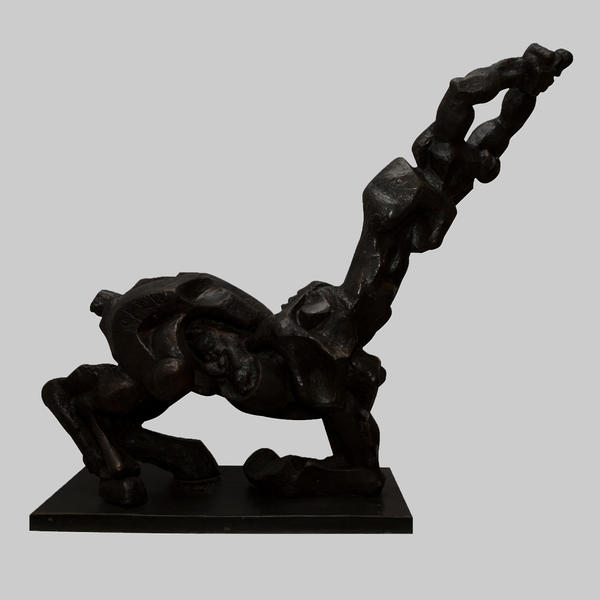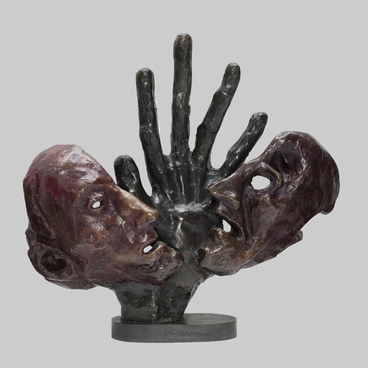Ernst Iosifovich Neizvestny was born in Sverdlovsk (now, Yekaterinburg) in 1925 to the family of an otorhinolaryngologist, Iosif Moiseyevich Neizvestny. Since his green years, he took part in various artistic competitions. In 1942, Ernst Neizvestny went to the Leningrad Secondary Art School, but he had to suspend his schooling: he was enlisted in the Red Army and was only able to resume art studies after the Victory. After the war, Neizvestny continued his art education at the Academy of Arts in Riga and the Surikov Art Institute in Moscow. In 1955, he was admitted to membership in the USSR Union of Artists but was expelled seven years later. In 1976, Ernst Neizvestny moved to the United States of America and continued his career.
Ernst Neizvestny often turned to the mythical character of the centaur in his art. The wild creature with a human torso and a horse body was the best means to convey the famous sculptor’s idea of the controversial human nature. Neizvestny’s centaurs are a synthetic product of nature and engineering, half-people and half-machines, uniting the natural beauty of the human body and the power of man-made implements.
As he worked on his sculptures, Neizvestny was inspired by the cultures of ancient peoples — Egyptians, Indians, Greeks, Mexicans. By skillfully combining the past, the present, and the future, he created sculptures that became symbols of modern civilization.
In his reminiscences, the sculptor noted that he had drawn centaurs when a child yet, without charging them with any hidden message. That mythical creature had always attracted him. As a grown-up person, Neizvestny said that he had come to like the centaur for his dialogicalness. The sculptor explained: ‘I don’t like monological things: my sculpture is dialogical, my life is dialogical, all my aspirations are about ‘yes’ and ‘no’, the thesis and antithesis.’
Ernst Neizvestny called the 20th century the centaur time, i. e., transitional from some forms to others. He saw in the centaur a natural merger of human and animal nature with modern technologies. The artist argued: “We are centaurs. For example, when I am talking, my voice goes on with the tape, my face is with the video. Technology penetrates our eyes, hands, voice, heart. We are combined with technology like a Scythian with the horse in the past or a human torso with that of a horse.” He pointed out that people don’t realize themselves how deeply technology has penetrated our mind; he thought that the combination of the two natures is plastic. He called that symbiosis a dialogue in which the borderlines are blurred between the living and non-living, the animal and the human, the masculine and the feminine, the conscious and the unconscious.
Ernst Neizvestny often turned to the mythical character of the centaur in his art. The wild creature with a human torso and a horse body was the best means to convey the famous sculptor’s idea of the controversial human nature. Neizvestny’s centaurs are a synthetic product of nature and engineering, half-people and half-machines, uniting the natural beauty of the human body and the power of man-made implements.
As he worked on his sculptures, Neizvestny was inspired by the cultures of ancient peoples — Egyptians, Indians, Greeks, Mexicans. By skillfully combining the past, the present, and the future, he created sculptures that became symbols of modern civilization.
In his reminiscences, the sculptor noted that he had drawn centaurs when a child yet, without charging them with any hidden message. That mythical creature had always attracted him. As a grown-up person, Neizvestny said that he had come to like the centaur for his dialogicalness. The sculptor explained: ‘I don’t like monological things: my sculpture is dialogical, my life is dialogical, all my aspirations are about ‘yes’ and ‘no’, the thesis and antithesis.’
Ernst Neizvestny called the 20th century the centaur time, i. e., transitional from some forms to others. He saw in the centaur a natural merger of human and animal nature with modern technologies. The artist argued: “We are centaurs. For example, when I am talking, my voice goes on with the tape, my face is with the video. Technology penetrates our eyes, hands, voice, heart. We are combined with technology like a Scythian with the horse in the past or a human torso with that of a horse.” He pointed out that people don’t realize themselves how deeply technology has penetrated our mind; he thought that the combination of the two natures is plastic. He called that symbiosis a dialogue in which the borderlines are blurred between the living and non-living, the animal and the human, the masculine and the feminine, the conscious and the unconscious.



